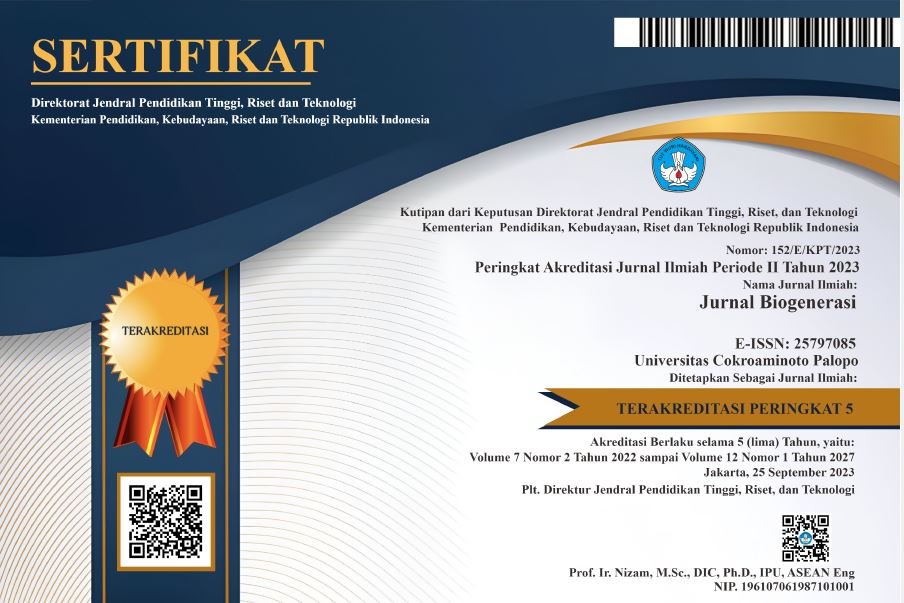KARAKTERISTIK BEADS ISOLAT KONSORSIUM BAKTERI TERMOFILIK PENGHASIL BIOLISTRIK
DOI:
https://doi.org/10.30605/biogenerasi.v10i2.6083Keywords:
Alginate, Thermophilic bacteria, Immobilization, Consortium, Microbial Fuel CellAbstract
Alginate matrix in the form of beads plays an important role in the process of immobilizing bacteria and maintaining their viability and stability in Microbial Fuel Cell (MFC) systems. The use of beads contributes to increasing the efficiency of electron transfer from bacteria to electrodes, thus supporting more optimal biolectricity production. This study aims to assess the characteristics of beads resulting from the immobilization of isolates of bioelectric-producing thermophilic bacterial consortium. The research method used was descriptive with visual observation of the color, shape, diameter, and number of bacterial colonies on the beads. Beads were synthesized from 5% sodium alginate solution mixed with six combinations of bacterial isolates (MS 9&12, MS 9&17, MS 9&18, MS 12&17, MS 12&18, and MS 17&18). The results showed that all beads had a round shape, yellowish white color, and diameter between 3.0 mm to 4.0 mm. The largest diameter was produced by the combination of MS 12&18 and MS 17&18 isolates, while the largest number of colonies was found in the combination of MS 12&17.
Downloads
References
Christiane, A., & Priyanto, H. (2016). Pengaruh Kualitas Beads terhadap Viabilitas Bakteri Terimobilisasi. Jurnal Bios Logos, 7(1), 40-47.
D'haeseleer, P., Gladden, J. M., Allgaier, M., Chain, P. S., Tringe, S. G., Malfatti, S. A., ... & Singer, S. W. (2013). Proteogenomic analysis of a thermophilic bacterial consortium adapted to deconstruct switchgrass. PLoS One, 8(7), e68465.
Fu, S., Thacker, A., Sperger, D. M., Boni, R. L., Buckner, I. S., Velankar, S., ... & Block, L. H. (2011). Relevance of rheological properties of sodium alginate in solution to calcium alginate gel properties. Aaps Pharmscitech, 12, 453-460.
Lee, B. B., Ravindra, P., & Chan, E. S. (2013). Size and shape of calcium alginate beads produced by extrusion dripping. Chemical Engineering & Technology, 36(10), 1627-1642.
Lehmann, M., Prohaska, C., Zeldes, B., Poehlein, A., Daniel, R., & Basen, M. (2023). Adaptive laboratory evolution of a thermophile toward a reduced growth temperature optimum. Frontiers in Microbiology, 14, 1265216.
Mubarokah, I. (2018). Pengaruh konsentrasi alginat terhadap karakteristik sel Pseudomonas fluorescens. Disertasi: Universitas Brawijaya.
Obileke, K., Onyeaka, H., Meyer, E. L., & Nwokolo, N. (2021). Microbial fuel cells, a renewable energy technology for bio-electricity generation: A mini-review. Electrochemistry Communications, 125, 107003.
Palupi, N. W., Setiadi, P. K. J., & Yuwanti, S. (2014). Enkapsulasi cabai merah dengan teknik coacervation menggunakan alginat yang disubstitusi dengan tapioka terfotooksidasi. Jurnal Aplikasi Teknologi Pangan, 3(3).
Purba, G. S., Widyastuti, T. E. W., & Kuswardhani, I. (2016). Pengaruh konsentrasi tepung pepaya dan lama penyimpanan terhadap sifat fisik beads dan viabilitas lactobacillus acidophilus fncc 0051 terimobil. Jurnal Teknologi Pangan dan Gizi (Journal of Food Technology and Nutrition), 15(2), 79-86.
Scott, I. M., Rubinstein, G. M., Poole, F. L., Lipscomb, G. L., Schut, G. J., Williams-Rhaesa, A. M., ... & Adams, M. W. (2019). The thermophilic biomass-degrading bacterium Caldicellulosiruptor bescii utilizes two enzymes to oxidize glyceraldehyde 3-phosphate during glycolysis. Journal of Biological Chemistry, 294(25), 9995-10005.
Shrestha, N., Tripathi, A. K., Govil, T., Sani, R. K., Urgun-Demirtas, M., Kasthuri, V., & Gadhamshetty, V. (2020). Electricity from lignocellulosic substrates by thermophilic Geobacillus species. Scientific Reports, 10(1), 17047.
Summaiati, T., & Irdawati, I. (2024). Variations in Alginate Concentration as a Material for Immobilizing Thermophilic Bacteria on the Characteristics of Beads. Jurnal Serambi Biologi, 9(2), 187-192.
Sun, Q., Yin, S., He, Y., Cao, Y., & Jiang, C. (2023). Biomaterials and encapsulation techniques for probiotics: Current status and future prospects in biomedical applications. Nanomaterials, 13(15), 2185.
Uemura, N. A., & Nakane, D. (2025). Type IV Pili in Thermophilic Bacteria: Mechanisms and Ecological Implications. Biomolecules, 15(4), 459.
Downloads
Published
How to Cite
Issue
Section
License
In submitting the manuscript to the journal, the authors certify that:
- They are authorized by their co-authors to enter into these arrangements.
- The work described has not been formally published before, except in the form of an abstract or as part of a published lecture, review, thesis, or overlay journal.
- That it is not under consideration for publication elsewhere,
- That its publication has been approved by all the author(s) and by the responsible authorities – tacitly or explicitly – of the institutes where the work has been carried out.
- They secure the right to reproduce any material that has already been published or copyrighted elsewhere.
- They agree to the following license and copyright agreement.
License and Copyright Agreement
Authors who publish with this journal agree to the following terms:
- Authors retain copyright and grant the journal right of first publication with the work simultaneously licensed under Creative Commons Attribution License (CC BY 4.0) that allows others to share the work with an acknowledgment of the work's authorship and initial publication in this journal.
- Authors are able to enter into separate, additional contractual arrangements for the non-exclusive distribution of the journal's published version of the work (e.g., post it to an institutional repository or publish it in a book), with an acknowledgment of its initial publication in this journal.
- Authors are permitted and encouraged to post their work online (e.g., in institutional repositories or on their website) prior to and during the submission process, as it can lead to productive exchanges, as well as earlier and greater citation of published work.


.png)

